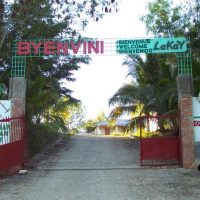Thomassique

Thomassique (Pop. 42,557) is a city-ship of the Cerca la Source Arrondissement, part of Centre Division of Haiti. As a rural area with a population of 42,557, its resources are challenged, especially with regard to clean drinking water.
The Thomassaic city was founded in 1950 and raised to the rank of commune in 1954. The town of Thomassique has two communal sections: Matelgate and Lociane, subdivided into 49 and 64 localities respectively. The dominant relief of the town is the plateau and its climate is considered normal. Unlike the city of Thomonde for example, the city of Thomassique contains (from 1980) several areas of extension, eight in total. The Inhabitants of this commune Thomassique call themselves Thomassiquois. In 1998, the population of Thomassique was estimated at 37,306 inhabitants with a density equal to 141 inhabitants / km2.
Economy: The local economy is based on the production of cotton , lime and sugar cane . The farming is an industry developed by farmers and harvesting honey in hives. Livestock, Agriculture and Trade are the main economic activities of the municipality. For other products, traders buy from other towns such as: Hinche, Saint-Raphaël and Cerca-la-Source. The Dominican Republic is also a point of supply for the inhabitants of the town of Thomassique. As for other communes of the Central department, the town of Thomassique is very poorly endowed from the point of view of infrastructures as much social, economic as cultural.
Transportation: The roads that lead from the city to the communal sections or that connect the communal sections to each other consist of trails and paths.
The road to Hinche, as described in a letter:
The other day, a friend of mine asked me to drive a car for him from Thomassique to Hinche. I am telling you, this is either the roughest massage of my life or a real punishment.
I don’t think there are any roads in the entire world worse than that stretch of road from Thomassique to Hinche Haiti.
I drove and and drove and drove, up and down, side to side, upside down, only to realize that I was just a few kilometers away… I finally reached the town of Los Palis.
Jesus…. And to think… My friend does this all the time… No wonder he is so skinny… Fighting with that darn steering wheel must be a real fat burner.
I am telling you… Man… If you want to punish somebody, make him drive from Hinche to Thomassique Haiti. If you really hate hate him, make him drive back to Hinche on the same day…
Education: There is no representative of the Ministry of National Education of Youth and Sports in the municipality. Inventoried were 46 mainly private primary schools, 13 literacy centers and 5 secondary schools.
Health: The Ministry of Public Health and Population is not represented in the commune. There are only two private clinics. In addition, a doctor, four auxiliaries, and a few dozen certified matrons ensure the sanitary service in the commune.
Health Issues: Since the 2010 earthquake toppled the infrastructure of Haiti, lack of purified drinking water has been a pressing issue. Dust, debris, and sewage from the fallout of the quake entered the water systems over much of the country, causing high rates of cholera among populations. Symptoms of cholera: dehydration, diarrhea, vomiting, and cramping, if not treated quickly, can lead to coma and death.
Utilities: For water supply, the town has four rivers, four springs, several dozen faucets and a pump for domestic use. The town was not electrified at the time of the survey. Telephone and the postal service were also non-existent. Thomassique residents have two water sources to draw from: a river nearby and water pumped through a delivery system from Cerca la Source. The water is impure and at times contains poisonous levels of cholera bacteria.
Many non-government organizations have flocked to Haiti to help rebuild the country’s infrastructure. One of these, a group of Duke University students, is working on a project to instruct the townspeople on safe water practices.
Situation: The students have seen first-hand the heart-breaking living conditions of Thomassique: flimsy wood huts and public spaces with only timber stanchions and corrugated tin roofs to protect them from the blistering sun.
The goal of the project is to raise the standards of water sanitation and its impact on the incidence of cholera cases, to meet the World Health Organization’s WASH requirements.
In response, the students are conducting information sessions on clean drinking water; appropriate hygiene and sanitation practices; and how to disinfect drinking water through solar disinfection in Thomassique.

